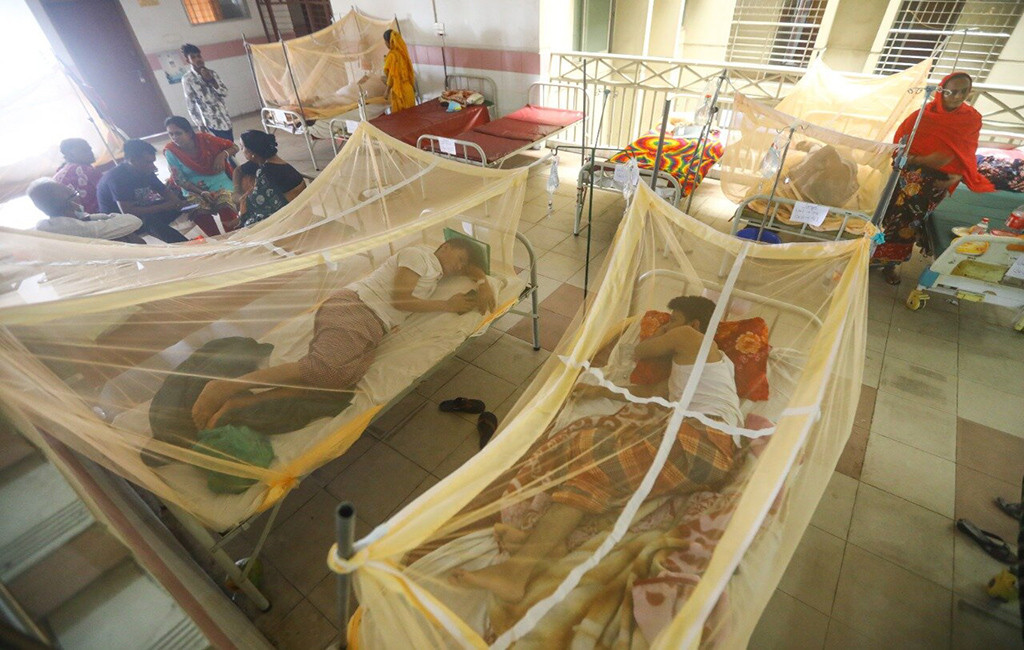The survey identified high-rise buildings in Dhaka as having the highest number of Aedes larvae

A recent survey conducted in Dhaka city has revealed that the average density of Aedes larvae in two city corporation areas within the metropolis is a staggering 24.89%, surpassing the safety threshold.
This alarming situation indicates a potential public health crisis, as a larval density above 20% is considered an indication that the situation is out of control.
Of particular concern are multi-storied and high-rise buildings, where the rates spike to 49.52% in Dhaka North City Corporation (DNCC) and 41.15% in the Dhaka South City Corporation (DSCC).
This escalating larval density highlights the urgent need for effective measures to combat the Aedes mosquito population and mitigate the risk of mosquito-borne diseases in Dhaka.
The pre-season survey conducted by the Directorate General of Health Services (DGHS) has revealed a deeply concerning situation. The disease control wing of the department conducted the survey in two city corporation areas of the capital from June 18 to 25.
The survey identified high-rise buildings as having the highest number of Aedes larvae.
Specifically, the density of larvae in multi-storied buildings of DNCC was recorded at 49.52%.
Similarly, in DSCC, multi-storied buildings exhibited a larvae density of 41.15%. In addition to this, larvae were discovered at alarming rates in houses, under-construction structures, and vacant land.
Furthermore, larvae were found in various containers such as plastic drums, mugs, tires, and cement water tanks.
The survey revealed alarming findings regarding the presence of Aedes mosquito larvae in residential areas.
In the DNCC area, larvae were found in 21.8% of houses, while in the DSCC area, the figure stood at 15.7%.
A detailed inspection of 1,549 houses in DSCC unveiled a total of 1,744 wet pots, with 15.07% of these houses containing mosquito larvae.
Similarly, DNCC inspected 962 houses and discovered 994 wet containers, with approximately 27.87% of them housing mosquito larvae.
Dengue count
The information on alarming rise in larvae density comes at a time when four more deaths were reported from dengue in 24 hours till Monday morning.
The fatalities from the mosquito-borne disease in Bangladesh now stands at 56 this year.
During the period, 436 more patients were hospitalized with the viral fever, according to the Directorate General of Health Services (DGHS).
Of the new patients, 174 were admitted to hospitals in Dhaka and the rest outside it, according to DGHS.
A total of 1,531 dengue patients, including 1,022 in the capital, are now receiving treatment at hospitals across the country.
So far, the DGHS has recorded 9,193 dengue cases, 7,606 recoveries this year.
Earlier, Health Minister Zahid Maleque said the number of patients infected with dengue is five times higher than in the previous year in the past five months.
In 2022, a total of 281 people died of dengue infection while another 101 died in 2021. In 2020 and 2019 a total of 179 people died. Last year, a record 62,282 persons were infected with the disease.
This year, the number of dengue patients in the hospital increased prior to the rainy season. The Rohingya camps in Cox's Bazar have been hit hard by dengue, with 1,066 cases reported this year.
Concerning situation
Experts are deeply concerned about the current dengue situation, which has reached a critical level even before the official dengue season begins.
This unprecedented scenario poses a grave threat to Bangladesh, as the severity of the situation surpasses any previous experiences. Urgent and intensified control measures are imperative to avert the impending disaster that dengue could unleash this year.
Dr Kabirul Bashar, an entomologist and professor at Jahangirnagar University, has issued a warning about the potential surge in dengue infections in the coming days due to the high larval density discovered in the survey.
He also emphasized that the calculations made before the recent rainfall may not accurately reflect the current situation. The accumulated rainwater in abandoned containers provides fertile breeding grounds for Aedes mosquitoes, leading to the hatching of larvae, pupae, and ultimately, the emergence of flying mosquitoes. Urgent and large-scale efforts are required to intensify dengue control activities in order to avert a disastrous outbreak this year.
According to the DGHS, the primary responsibility for controlling Aedes mosquitoes lies with the city corporations. Therefore, it is crucial for city corporations to take immediate action to combat dengue.
Professor Dr Nazmul Islam, Director of DGHS, acknowledged the severity of the situation depicted in the survey, even though the official dengue season has yet to commence. The complete report will be published soon, after which the city corporations will assume responsibility for the remaining dengue control efforts.
DNCC, DSCC drives continue
In the meantime, the two city corporations in Dhaka have been carrying out routine activities to control dengue. However, they have intensified their efforts following the recent increase in dengue cases.
Dr Fazle Shamsul Kabir, the chief health officer of DSCC, has announced that multiple crash programs have been implemented in the high-risk areas identified through the health department's survey.
To intensify the efforts, a dengue eradication combing operation will be conducted for three days, starting on the 5th and 6th of July. Additionally, mobile courts have been actively operating since June to address the issue, he added.
Brigadier General AKM Shafiqur Rahman, the chief health officer of DNCC, stated that in order to effectively combat dengue, the Eid leave for all mosquito control workers has been canceled. The operation is being executed by gathering the home addresses of patients admitted to hospitals.
Furthermore, school-to-school dengue eradication programs have been implemented to raise awareness among students, he added.
The authorities remain hopeful that these measures will bring the situation under control.












